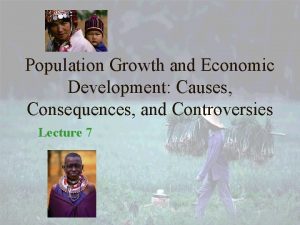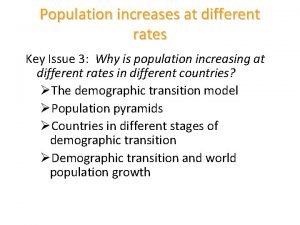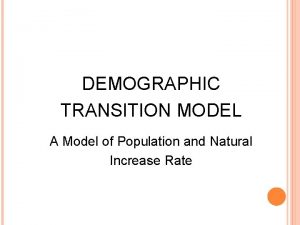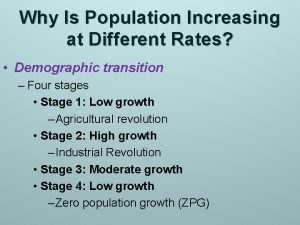Why Is Population Increasing at Different Rates A


























- Slides: 26

Why Is Population Increasing at Different Rates? A country’s stage of demographic transition gives it a distinctive population structure. Population in a country is influenced by the demographic transition in two important ways: % of pop in each age group Distribution of males and females

Why Is Population Increasing at Different Rates? Population pyramids-p. 62 -63 A bar graph showing a place’s age and sex composition Shape of the pyramid is determined mainly by the CBR Age distribution Dependency ratio-# of people too young or too old to work, compared to # of people in their productive years. Sex distribution Sex ratio-# of males per 100 females in the pop.

Population Pyramids See p. 64 Figure 2 -16

Percent of Population under 15 Fig. 2 -15: About one-third of world population is under 15, but the percentage by country varies from over 40% in most of Africa and some Asian countries, to under 20% in much of Europe.

Why Is Population Increasing at Different Rates? Countries are in different stages of the demographic transition Three examples: Cape Verde = High growth Stage 2 since the 1950 s Chile = Moderate growth Stage 3 since the 1960 s Denmark = Low growth Stage 4 since the 1970 s

Rapid Growth in Cape Verde Fig. 2 -17: Cape Verde, which entered stage 2 of the demographic transition in about 1950, is experiencing rapid population growth. Its population history reflects the impacts of famines and out-migration.

Moderate Growth in Chile Fig. 2 -18: Chile entered stage 2 of the demographic transition in the 1930 s, and it entered stage 3 in the 1960 s.

Low Growth in Denmark Fig. 2 -19: Denmark has been in stage 4 of the demographic transition since the 1970 s, with little population growth since then. Its population pyramid shows increasing numbers of elderly and few children.

Why Is Population Increasing at Different Rates? Demographic transition & world population growth Most countries = stage 2 or stage 3 of the Demographic Transition Stages 2 and 3 are characterized by significant population growth No country is in stage 1 of the demographic transition It is easier to cause a drop in the CDR than in the CBR

Key Issue 4 Why Might the World Face an Overpopulation Problem?

Why Might Overpopulation be a Concern? Thomas Malthus on overpopulation: One of the first to argue that the world’s rate of population increase was far outrunning the development of food supplies. An Essay on the Principle of Population (1798): Population grows geometrically while food supply grows arithmetically

Why Might Overpopulation be a Concern? Neo-Malthusians: Argue that 2 characteristics of recent population growth make Malthus’s thesis even more scary than it was 200 years ago: Malthus failed to predict that LDCs would have the most rapid pop growth because of medical technology not wealth World pop is not only exceeding food production, but other resources, like clean air, suitable farmland, and fuel

Why Might Overpopulation be a Concern? Criticism of Malthus includes the following: Pessimistic viewpoint Ideas based on a belief that the world’s supply of resources is fixed rather than expanding. Failure to consider technological innovation Larger pop could stimulate economic growth Marxist critique Argue that issues like poverty, hunger, and social welfare problems are due to unjust social and economic institutions, not pop growth

Malthus: Theory & Reality Figure 2 -25

Food and Population, 1950– 2000 Malthus vs. Actual Trends Fig. 2 -20: Malthus predicted population would grow faster than food production, but food production actually expanded faster than population in the second half of the

Why Might Overpopulation be a Concern? The NIR only declines for 2 reasons: lower CBR or higher CDR. Declining birth rates Reasons for declining birth rates: Reliance on economic development Improving local economic conditions, including education and health care Distribution of contraceptives Reducing birth rates with contraception Opposition for religious and political reasons

Crude Birth Rate Decline, 1981– 2001 Fig. 2 -21: Crude birth rates declined in most countries between 1981 and 2001 (though the absolute number of births per year increased from 123 to 133 million).

Family Planning Figure 2 -22

Why Might Overpopulation be a Concern? World health threats The epidemiologic transition Stage 1: Pestilence and famine The Black Plague Pandemics

Why Might Overpopulation be a Concern? World health threats The epidemiologic transition Stage 2: Receding pandemics Cholera and Dr. John Snow

Cholera in London, 1854 Fig. 2 -23: By mapping the distribution of cholera cases and water pumps in Soho, London, Dr. John Snow identified the source of the waterborne epidemic.

Why Might Overpopulation be a Concern? World health threats The epidemiologic transition Stage 3: Degenerative diseases Most significant: Heart disease and cancer Stage 4: Delayed degenerative diseases Medical advances prolong life

Why Might Overpopulation be a Concern? World health threats The epidemiologic transition A possible stage 5: Reemergence of infectious diseases? Three reasons why it might be happening: Evolution of disease Poverty Improved travel

Tuberculosis Death Rates, 2000 Fig. 2 -24: The tuberculosis death rate is a good indicator of a country’s ability to invest in health care. TB is still one of the world’s largest infectious-disease killers.

SARS Infections in China, 2003 Fig. 2 -25: China had 85 percent of the world's SARS cases in 2003. Within China, the infection was highly clustered in Guangdong Province, Hong Kong, and Beijing.

HIV/AIDS Prevalence Rates, 2002 Fig. 2 -26: The highest HIV infection rates are in sub-Saharan Africa. India and China have large numbers of cases, but lower infection rates at present.
 What is a unit ratio
What is a unit ratio Ratios guided notes
Ratios guided notes Ratios rates and unit rates
Ratios rates and unit rates Ratios rates and unit rates
Ratios rates and unit rates Andreas carlsson bye bye bye
Andreas carlsson bye bye bye Why do different polymers have different properties
Why do different polymers have different properties Technicolor test
Technicolor test B and q candles
B and q candles Chapter 4 population ecology test answer key
Chapter 4 population ecology test answer key Population ecology section 1 population dynamics answer key
Population ecology section 1 population dynamics answer key Population ecology section 1 population dynamics
Population ecology section 1 population dynamics Chapter 4 population ecology answer key
Chapter 4 population ecology answer key Dont ask
Dont ask Population pyramid types
Population pyramid types Why population growth is good
Why population growth is good Why do geographers use population pyramids
Why do geographers use population pyramids Key issue 3 why does population growth vary among regions
Key issue 3 why does population growth vary among regions Why does population growth vary among regions
Why does population growth vary among regions Sound will travel at different speeds in different mediums.
Sound will travel at different speeds in different mediums. Library thinkquest org 19537
Library thinkquest org 19537 Different culture have different moral codes
Different culture have different moral codes Different angle different story
Different angle different story Acids and bases song
Acids and bases song Manufactured boards examples
Manufactured boards examples Different people different things
Different people different things Argumenterande tal struktur
Argumenterande tal struktur Graphing transformations
Graphing transformations

















































